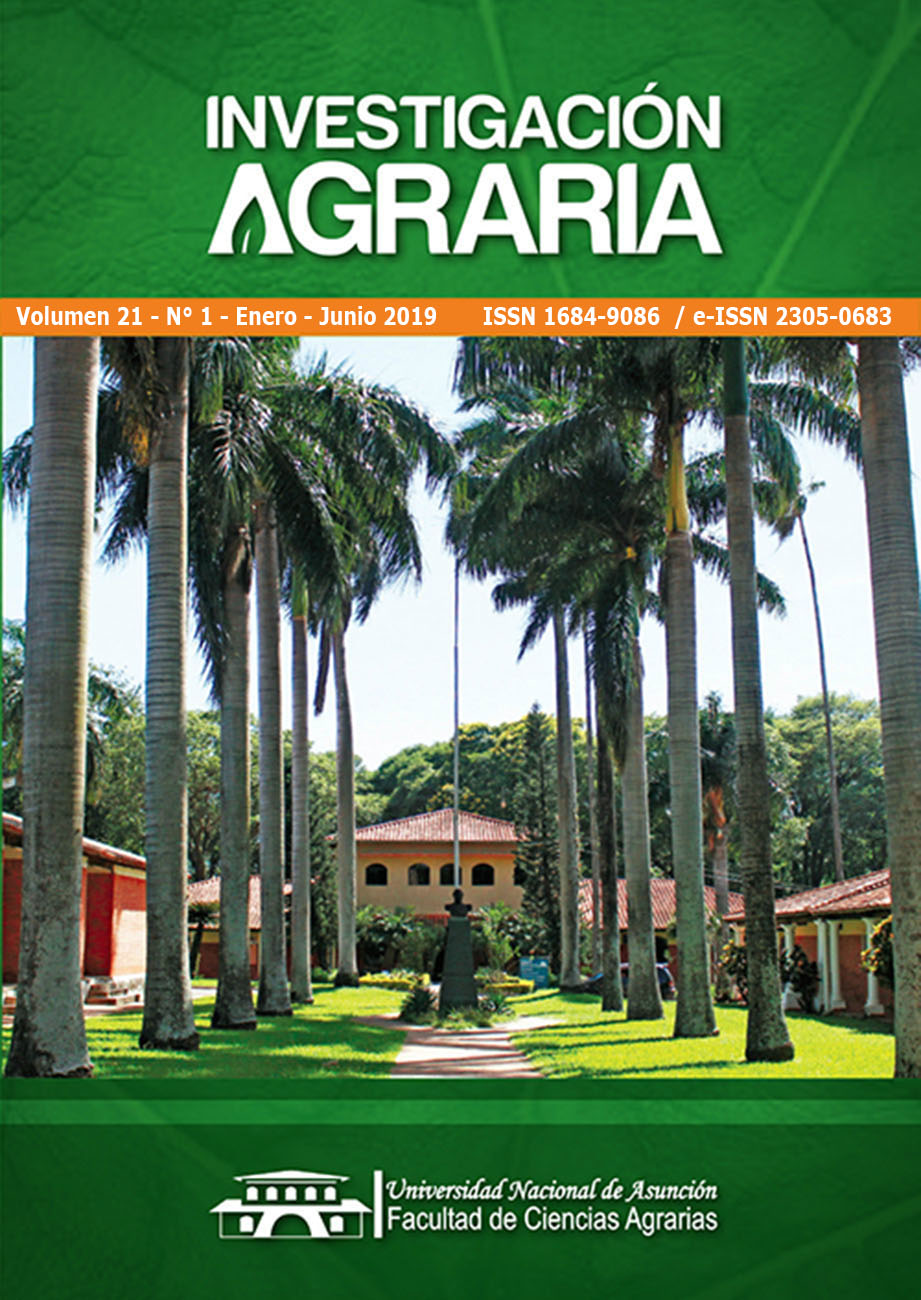Surface designs to determine the levels of N and P that maximize yield of tomato
DOI:
https://doi.org/10.18004/investig.agrar.2019.junio.31-42%20Keywords:
Lycopersicum esculentum, response surfaces, nitrogen, phosphorusAbstract
The methodology of response surfaces, originally introduced by Box and Hunter in 1951, has allowed the development of several designs, such as the San Cristóbal Design developed by Rojas in 1962, for research with fertilizers (Chacín, 1998). In order to determine the influence of the application of levels (0 to 360 kg ha-1) of N and P2O5 on the tomato yield and the similarity of the surface models, estimated by response surface designs, the present research in environments of the National University of San Cristóbal de Huamanga (UNSCH), in Ayacucho, Peru. Tomato was cultivated in a protected environment, using four surface designs (Central Composite Design Rotable: DCCR, Design San Cristóbal: DSC, Design July 3: D3J and Complete Factorial: DFC). The results show that the yields of tomato fruits obey the models: Y = 12292 + 104.77794*N + 87.27649*P2O5 - 0.12524*N² - 0.13156*P2O5² - 0.05242*N*P2O5 (DCCR); Y = 13121 + 102.98407*N + 51.88371*P2O5 - 0.14659*N² - 0.02645*P2O5² + 0.00512*N*P2O5 (D3J); Y = 13255 + 120.28556*N + 97.79306*P2O5 - 0.24539*N² - 0.16289*P2O5² + 0.07365*N*P2O5 (DSC); Y = 11401 + 103.54156*N + 83.1667*P2O5 - 0.17911*N² - 0.14172*P2O5² + 0.0747*N*P2O5 (DFC). It is concluded that: 1. N (urea) has a greater influence than P2O5 (triple superphosphate) on the yield of tomato fruits; 2. There is greater similarity between the estimated values corresponding to the DCCR and D3J designs, with those of the DFC, showing better results at average levels of N and P2O5 (180 kg ha-1).Downloads
Metrics
References
Araujo, J.C., Telhado, S.F.P., Sakai, R.H., Ledo, C.A.S. & Melo, P.C.T. (2016). Univariate and multivariate procedures for agronomic evaluation of organically grown tomato cultivars. Horticultura Brasileira, 34(3), 374-380.
Berrospe-Ochoa, E.A., Ordaz-Chaparro, V.M., Rodríguez-Mendoza, M.N. y Quintero-Lizaola, R. (2012). Cachaza como sustrato para la producción de plántula de tomate. Revista Chapingo (Serie Horticultura), 18(1), 141-156.
Briones-Encinia, F. y Martínez-Garza, A. (2002). Eficiencia de algunos diseños experimentales en la estimación de una superficie de respuesta. Agrociencia, 36 (2), 201-210.
Chacín, F. (1998). Análisis de Regresión y Superficie de Respuesta. Maracay, Venezuela: Universidad Central de Venezuela, Facultad de Agronomía. 274 p.
Coutinho Edson, L.M., Orioli Júnior, V., Silva, E.J., Coutinho Neto, A.M. y Cardoso, S.S. (2014). Nutrición, producción y calidad de frutos de tomate para procesamiento en función de la fertilización con fósforo y potasio. Agrociencia Uruguay, 18(2), 40-46.
Jiménez Careaga, M.G. (2015). Superficies de Respuesta mediante un Diseño Central Compuesto. Revista Varianza, 2015(11), 31-36.
Marouelli, W.A., Souza, R.B., Braga, M.B. & Silva, W.L.C. (2014). Evaluation of sources, doses and application schedules of nitrogen on drip-irrigated tomato. Horticultura Brasileira, 32(3), 327-335.
Martínez Garza, A. (1988). Diseños experimentales: Métodos y elementos de teoría. Ciudad de México, México: Trillas, 756 p.
Montgomery, D. (2004). Diseño y análisis de experimentos. 2 ed. Ciudad de México, México: Limusa Wiley, 686 p.
Monzón Sequeiros, C.A. (2016). Evaluación del rendimiento de tomate de crecimiento indeterminado (Lycopersicum sculentum Mill) de variedades híbridos utilizando abonos fermentados de gallinaza y cuyaza – Abancay. Tesis Ingenieria. Ayacucho, Perú: Universidad Tecnológica de Los Andes, 151 p.
Perrens Orué, O.K., Enciso Garay, C.R. y Ríos Arévalos, R. (2008). Evaluación de variedades e híbridos de tomate rastrero. Investigación Agraria, 10(2),5-9.
Tineo Bermúdez, A.L. (2014). Superficies de Respuesta: El Diseño 03 de Julio (Aplicaciones agronómicas). Ayacucho, Perú: Universidad Nacional de San Cristóbal de Huamanga. 145 p.
Tineo Bermúdez, A.L. (2015). Maximización del rendimiento de tomate (Lycopersicum esculentum) por aplicación de nitrógeno y fósforo. Ayacucho, 2015. Informe final de investigación 2015. IIFCA-UNSCH. Ayacucho, Perú. Universidad Nacional de San Cristóbal de Huamanga, 32 p.
Downloads
Published
How to Cite
Issue
Section
License

This work is licensed under a Creative Commons Attribution 4.0 International License.
All content in this journal is under Creative Commons Attribution License.









 All content in this journal is under
All content in this journal is under 